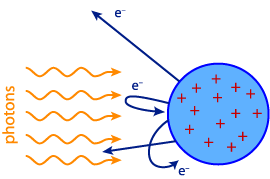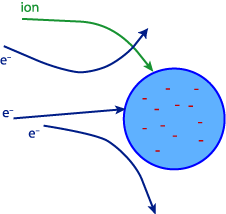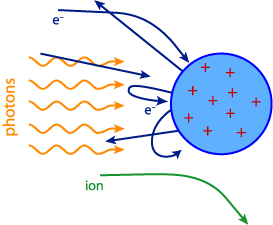
Online Help
Main
Basics
("EFW for
dummies")
Validation
Pitfalls
EFW for Dummies
1. Hardware
2. Spheres
3. Iv curve
4. Current biasing
5. Modes
Related
EFW Home
Operations
|
2. Conducting Objects in a Sunlit Plasma
So if the probes don't assume the plasma potential, what do they do?
To answer this, we'll break the problem into 2 parts: the sunlit part and the plasma part of the problem.
2a. Sunlit conducting sphere in a vacuum
|

|
A conducting sphere in a vacuum will begin to photoelectrons when struck
by sunlight. As the electrons leave, the probe becomes positively charged.
This positive charging attracts some of the photoelectrons back to the sphere.
In a vacuum, the sphere will quickly reach an equilibrium condition in which
it attracts back all of the photoelectrons.
Escaping photoelectrons cause the sphere to charge positively.
This, in turn, decreases the number of photoelectrons that can actually escape.
|
2b. Conducting sphere in a dark plasma
|

|
A conducting sphere placed in a plasma will
be struck by both electrons and ions. The electrons, moving much faster,
strike the probe at a greater rate, and cause the probe to become negatively
charged. This negative charging repels some of the electrons that would
otherwise have hit the sphere (and also attracts a few ions). Equilibrium
results when the charge on the sphere is large enough that the electron and ion currents
balance.
Plasma electrons cause the sphere to charge negatively.
This, in turn, decreases the number of electrons that hit the sphere.
|
EFW is in a combination of the above environments: a sunlit plasma.
| 2c. Conducting sphere in a sunlit plasma
|

|
In
a sunlit plasma, the two effects compete to drive the sphere in different
directions. The escaping photoelectrons will try to drive the sphere
positive, while the plasma elecrons will try to drive the sphere negative.
In the plasma environments which EFW encounters, the first effect dominates,
and the object (in this case either the probe sphere or the satellite) becomes
positive.
Equilibrium is obtained when the sphere charges to a voltage such that:
Photoelectron current + Plasma ion current = Plasma electron current
|
Previous page
Up to table of contents
|



